Before I get into the story of “night life in early Eureka,” I want to describe as best I can the way Eureka looked from its beginning to the 1930s.
In the early 1850s, the City of Eureka was started in a small clearing in the redwood forest that grew right down to the bay. The first settlers lived in tents and small shacks. This land was not very level; it sloped back up inland and was crisscrossed with many deep gulches and sloughs (most are no longer in existence in that they have been filled in and built over with streets and homes).
The town was built along the bay with wharves built for ships to tie up. The only method of transportation to the bay was by ship and, likewise, everything was brought to the area by ships.
The streets were laid out north and south, east and west. First Street ran east/west along the bay; Second Street was next; then Third. The streets running north and south started with A Street and continued with B, C and so on.
The main stores were located along Second Street. The first Pioneer School was built on the southwest corner of Third and G streets. Children were not allowed to walk down to First and Second streets as there were many saloons and “bad elements” down there. The first church (Congregational) was constructed on Fourth and G streets and was right up against the redwood forest.
Eureka grew slowly during the next 60 years. By 1910 there were three manufacturing brickyards in Eureka, and four redwood saw mills and shingle mills. Lumber, along with good gravel and sand bars, and a good water supply made for readily available building materials.
The Occidental Pavilion, located at Second and A streets in Eureka, was torn down during October and November of 1940. Photos via the Humboldt Historian.
Eureka had built a beautiful courthouse, a city hall, several large buildings, theatres, banks and business houses. There were eight new large school buildings built throughout the town, along with several large hotels, including The Vance. The Armory Hall, where boxing matches were held, was on the northeast corner of Second and C streets and still stands today. Almost all of these buildings were located between Fourth Street and the bay. The Occidental Pavilion, a very beautiful, large building located at Second and A streets, was for many years used for fairs, carnivals, dances, banquets, plays, rollerskating, boxing matches and other activities.
In 1887 a horse-drawn streetcar system began in Eureka. In 1903 an electrical streetcar system was installed. This street railroad covered the main parts of Eureka until 1940 when it was abandoned in favor of a bus system.
Streets were graded and graveled, and sidewalks were built of redwood planks (there was very little street pavement or cement sidewalks until the 1930s). In 1914 the railroad to the south was completed, which helped development by making it easier and faster to come to Eureka.
Eureka was a seaport and logging town from the very beginning — a real working man’s town. As a result, soon came the “sporting girls.” These women worked in the dance halls, saloons and cabarets — places where the men and their money hung out. Eureka had more than its share of saloons, gambling houses and dance halls. In short, it was a “wide-open” town. In the 1800s, women working in the saloons enticed men to buy drinks. The woman might then invite him up to her room upstairs for a party and, if the man passed out, he would be relieved of his money, then tossed out.
In the 1920s there were several cabarets in Eureka, including the Blue-Bird Cabaret at 100 F St.; the Louvre, upstairs at 240 Second St.; the Woodland, 503 Second St.; Young’s Cabaret, 317 Second St.; the Olympia, First and E Streets; and the Dreamland Dime Dance Hall, upstairs at 325 Second St.; these cabarets employed about 25 women each. This Second Street was where the action was.
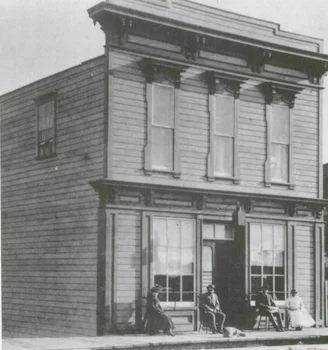
Kittie Farris’ Joy Emporium is pictured here on the corner of Second and D streets in Eureka, c. 1882. Photos via the Humboldt Historian. [Ed. note from 2025: The building still stands. Compare its current name to its original one.]
In these cabarets and dance halls there was always someone selling tickets at 10 cents apiece. These tickets were good for one, very short, i.e. two-minute, dance with your favorite girl. She would turn these tickets in at closing time and collect her pay for them. A good dancer and good company could make out pretty good. The woman would always ask you to buy her a drink, however, hers would be soda water even though you paid for an alcohol-loaded drink. The women got credit for the drinks they sold.
Most of these working girls were good looking and good conversationalists; they also dressed well. Just like anyone else, they had to make a living. Some were married and they took this job to supplement their husbands’ meager lumber mill salary.
A good many of these sporting girls had rooms over C.V. Jackson’s Store at Second and E streets, or other rooming houses down in that part of town. Some would make dates, meeting after the dance hall closed for the night. Some might turn a few tricks for a price if a man had the money.
Before you pass judgment, remember there were no food stamps, welfare system. Social Security or unemployment checks in those days; if you did not work, you did not eat. The system apparently worked as there were no homeless women on the streets.
The cabarets were very popular places, not only with the loggers and seamen, but also some of our local, prominent men who patronized these places. They, of course, did not tell their wives.
These dance halls and cabarets had some very good, small bands playing for the dances; many musicians got their start in these places. The performers received a few dollars for each night’s work.
Before Prohibition, whiskey, wine and beer flowed freely in Eureka’s saloons, gambling rooms and cabarets. With the passing of the Volstead Act in 1919, the country was required by law to be dry. But, as we well know, bootlegging whiskey and other spirits ran rampant not only in Eureka but throughout the nation. In all of the alcoholic drinks sold, it was bootleg whiskey, wine or beer that provided the punch.
The local “dry squads” and law enforcement officers were constantly raiding the various saloons and other spots, called blind-pigs or speakeasies, to catch anyone selling bootleg booze. The authorities did not have great success trying to control this activity.
This bootlegging went on for 13 years, up until ratification of the 21st Amendment in December 1933. During Prohibition the entire nation was in trouble with gang warfare over the bootlegging activity. Many murders by rival gangs were reported in the large cities of the country.
Whiskey was made throughout Humboldt County with many stills in the surrounding woods and mountains. Most of this “moonshine” corn whiskey sold by the bootleggers to the blind-pigs below Fourth Street went for $6 or less per gallon, depending upon the quality. Moonshine was sold in five-gallon tin cans. If not properly distilled, it could become poisonous, causing blindness, even death.
During the late summer, many truckloads of grapes from the south were delivered to various establishments along First and Second streets. They surely did not eat all these grapes, rather, they made them into wine to sell. This illegal wine, called “Dago-red,” could be quite good.
Many local people made home-brew beer, some of which was good, some terrible, all of which was against the law.
There were many arrests of bootleggers in Humboldt County, and some skulduggery amongst local county officials over bootleg whiskey. Some even went to prison over this. A portion of the confiscated booze disappeared from the storage room in the Humboldt County Courthouse. There was no shortage of thieves who would hijack the booze from the bootlegger, then sell it.
A time card used by the workings girls at Mission Rooms, 409 Third Street.
During this time there were many rooming houses in the area covered by A Street east to J Street and from Fifth Street north to the bay. Almost all of the two-story buildings in this area had “rooms” signs hanging in front. Most of these rooming houses were brothels, occupied by an older woman, called the madam, and her girls. The madam would see that proper decorum was maintained by the customers and working girls living there. She would be in charge of operations, collect a share of the money for the house and keep track of tricks turned by the women. The working girls kept timecards each night showing the number of drinks sold and tricks turned. These were turned in each night to the madam along with her cut of the take. These houses had from two to five women each. These “ladies of the night” would entertain loggers, seamen and many local men by selling drinks and other “services.” These places also doubled as blind-pigs where moonshine booze, whiskey, wine or beer could be bought.
This advertisement appeared in a 1903 brochure. “The Place,” located in the alley between F and G streets, and Second and Third streets, was most certainly a brothel.
These establishments would open for business in late afternoon and close at two or three in the morning. They sometimes stayed open all night, especially on Saturday nights when hundreds of loggers came to town on the logging trains. At other times there were several large freight and passenger ships in the harbor, bringing many sailors who had their pay to spend — and spend it they did.
Most of these houses had a small light hanging over the entrance, often red in color, hence, the name “Red Light District.” The stairs leading up to these rooms usually had one of the steps wired which, when stepped upon, would ring a buzzer in the madam’s room. This alarm enabled the residents to stash the booze in case of a raid by the “Dry Squad.” They knew when someone was coming up the stairs, friend or foe.
The local taxi cab drivers knew the location of all these places in Eureka. They had agreements with the madams for a cut of the take from the customers they would bring to their rooms. Strangers in town always asked the cabbies for directions and the cab drivers would ask a male visitor if he wished to see a woman. If the answer was “yes,” the cabbie would escort the man to one of these places.
Some of the women had boyfriends, called pimps. These fellows were often bartenders or cardsharps playing in local gambling establishments, or involved in doing some other menial task around town. They would inform other players or lonesome men of a place where they might find a woman who would show them a good time. These pimps would collect their share of the money from the women. During the 1920s and 1930s, the going price of a trick was $2. During the Civilian Conservation Corps days, the price paid by these C.C.C. boys was $1.50.
These “ladies of the night” patronized many of the local stores, paying cash for whatever they purchased. Many of them purchased the best clothes and shoes from Daly Brothers Big Store and other well-known establishments in Eureka. Most of them purchased their cosmetics, perfumes and medications from the Pacific Pharmacy on Second and F streets. The Eureka merchants had nothing but good words for these working girls as they were good paying customers. They never acted smart or sarcastic and never caused trouble, which was remarkable considering they had to deal with a lot of drunken, mean men.
If one of these women met a customer on the street the following day, she would never show any sign of recognition. Therefore, many of Eureka’s married men had nothing to fear in meeting these women on the street.
These sporting girls had examinations every two weeks by a local physician, either Dr. Carl Wallace or Dr. Sam Burre. Consequently, there was no epidemic or venereal disease in Eureka. If a case of venereal disease was brought into town by some out-of-town person, it was very soon detected by these doctors and taken care of.
These women did not need to solicit customers on the streets as they had plenty of walk-ins. Sometime they would beckon from their upstairs window to men passing by, inviting them to “come up and see me sometime.” They would usually sleep in until noon or later.
In 1949 the local Elks Lodge #652 started a drive to help the local Blood Bank. Eureka was divided into sections, with members delegated to sell tickets in each section. Four well-known members had the section from A Street east to J Street and from Fourth Street north to the waterfront. These four men sold more tickets and collected more money from the 35 local brothels in that section than all of the rest of the men collected in the entire city. These women were apparently very willing to help other people.
At Christmas time in Eureka, the Salvation Army could always count on these girls for large donations for the poor people, children and down-and-outers.
The Eureka Volunteer Fire Department would always sell more tickets to the Firemen’s Ball in this area than all the rest of Eureka — yet the girls never attended the party.
Many of these women had stories they could tell that would make the ordinary person’s blood run cold: abused childhoods, rapes, failed marriages, bad company, broken families. There were many reasons for their plight.
This oldest profession in history was very much a part of the history of Eureka and Humboldt County during the early 1930s. A count once made of the number of women following this profession in Eureka claimed over 250. There were well-known houses on the Humboldt Bay beach near the mouth of Elk River, the Old Triangle Road House on Elk River Corners, Johnie Wood’s Hotel at Freshwater Corners, and many such houses at Rio Dell and other places around Humboldt County.
Fire broke out in the Splendid Cafe in 1950. Upstairs were the Mission Rooms, Third and E streets. A small park now stands there, across from the Clarke Memorial Museum.
“The best little whorehouse” in Eureka was upstairs over the Mission Cigar Store on the northeast corner of Third and E streets, across E Street from the Clarke Museum (there is a park there today). A pretty woman called Jackie was the madam.
There was also the Alpine, Atlas, Carlton, Chester, Denver, Eureka, Gordon, Mecca, Royal, Ruby and Star Rooms. Mattie Well’s Hotel, Kitty Ferris’ Joy Emporium, the Model Rooms, Popular Hotel and Rex Rooms comprised some of the 30 or so places in Eureka. Most never had names and were just “rooms.” Some had entrances from the alleys and no numbers. A few are still standing today.
There was an African American house. This house, located on Summer Street between Fifth and Sixth streets, was operated by a black madam. She later opened a barbecued sparerib house at another location. She and her husband also catered banquets and receptions, and did a fine job.
It seems that much of gambling, card rooms, slot machines, punch boards, prostitution, bootlegging, speakeasies and other illegal operations were controlled by certain men in the area during these rough days. Sometimes referred to as the “Mafia,” these men were well known and made their fortunes in this business.
In 1942, during World War II, Eureka Mayor H.R. Simmons received orders from U.S. Army Headquarters to close the houses of prostitution, at least for the duration of the war. The mayor called a special meeting of the Eureka City Council and the city officials decided to follow orders. They tried…but were not very successful. Some of these displaced women obtained jobs at the Chicago Bridge and Iron Dry Dock Plant at the foot of Washington Street where they fared well at their new trade.
In the early 1950s there was a statewide movement outlawing this “social evil” and street-walking throughout the state. The mayors of Eureka, John Langer followed by Robert Madsen, followed this law and closed most of these places — or at least tried. They sent local police to raid these houses and arrested all offenders, both hookers and clients. A good many citizens did not approve of this action.
Many absurd aspects to this story exist: One night, during a raid of one of these houses by police, the officers discovered a prominent local businessman hiding unclothed in a closet, a very embarrassing situation for him. His name was never printed but word got around.
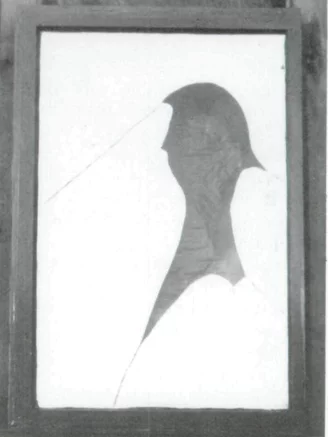
The windowpane broken by a brick which fell through June 6, 1932, during a 6.4 earthquake (a woman was killed by the brick as she lay in bed).
During the violent earthquake of June 6, 1932, when many chimneys were damaged in Eureka, bricks fell off the chimney of the Carson Building at Third and F streets into the alley between Second and Third streets. One brick crashed down through a window in a building on the other side of the alley, killing a woman in bed in this rooming house. The break in the window where the brick went through left a perfect silhouette of a woman’s head; a photograph of this phenomenon appeared in a local newspaper.
During November 1932, this writer was a young carpenter working for a contractor who had a contract to build a new, modern building on the north side of Second Street between C and D streets. This building was designed for a cardroom and “blind-pig” operation, complete with hidden trap doors and sliding panels for hiding booze. The second floor was designed for a brothel with several small bedrooms and, of course, a wired step in the stairway. I remember a very pretty blond lady coming by every few days in order that she might see how her new “house of pleasure” was coming along. She went by the name “Sugar.” It was said she got married and left the profession, but the building is still there.
There are many stories that can and cannot be told of incidents that occurred in these places during these times, so many that a rather colorful book could be written about the early history of the old “Downtown Eureka.”
###
The story above is excerpted from the May-June 1993 issue of the Humboldt Historian, a journal of the Humboldt County Historical Society. It is reprinted here with permission. The Humboldt County Historical Society is a nonprofit organization devoted to archiving, preserving and sharing Humboldt County’s rich history. You can become a member and receive a year’s worth of new issues of The Humboldt Historian at this link.
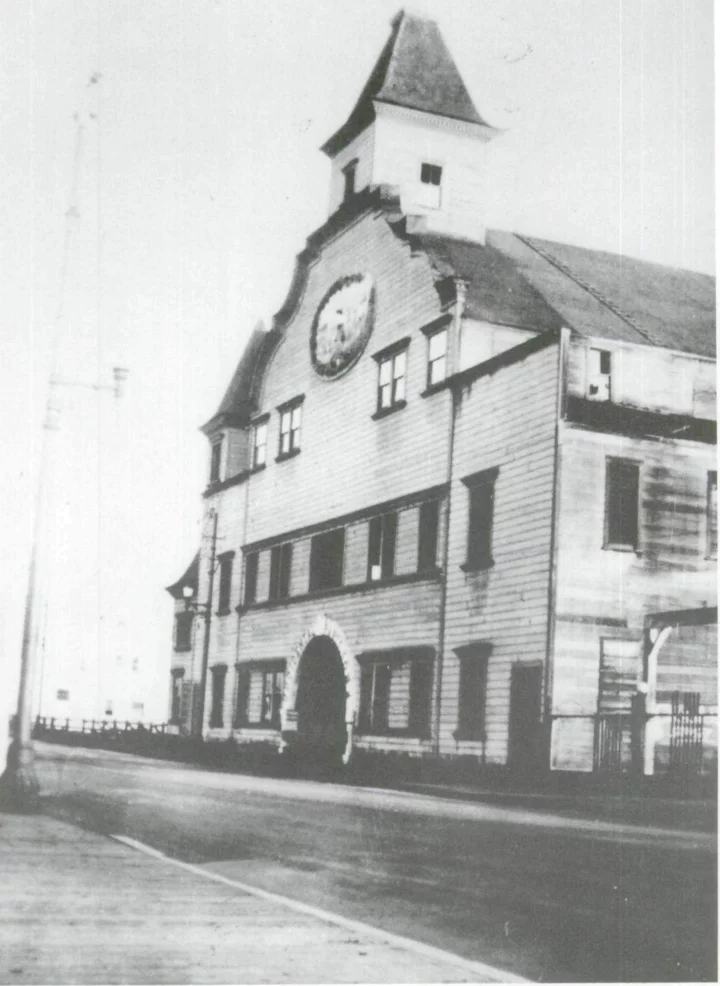
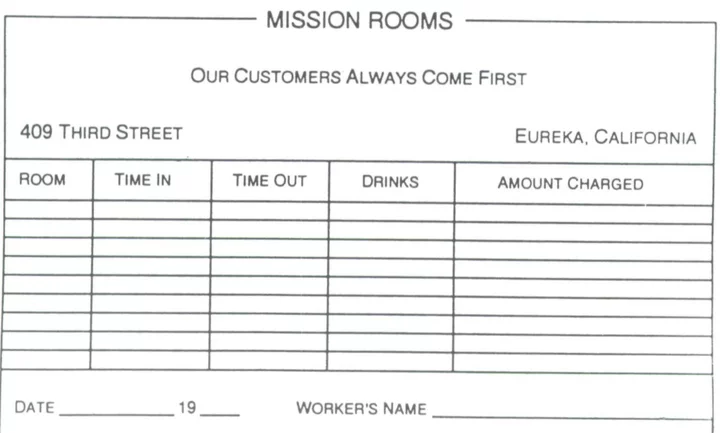

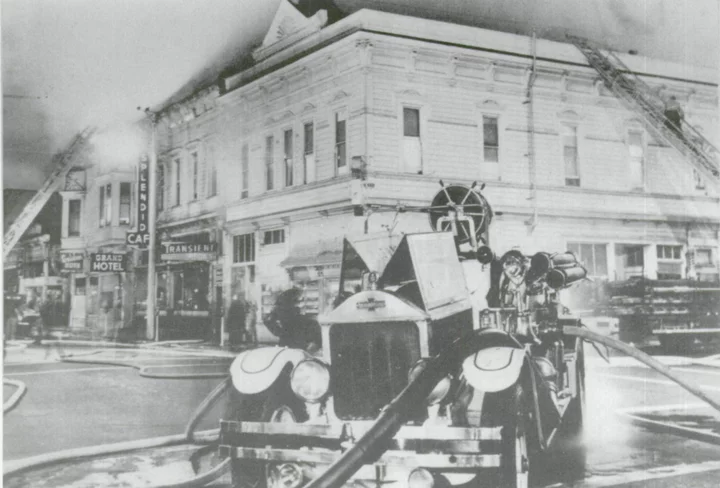
CLICK TO MANAGE